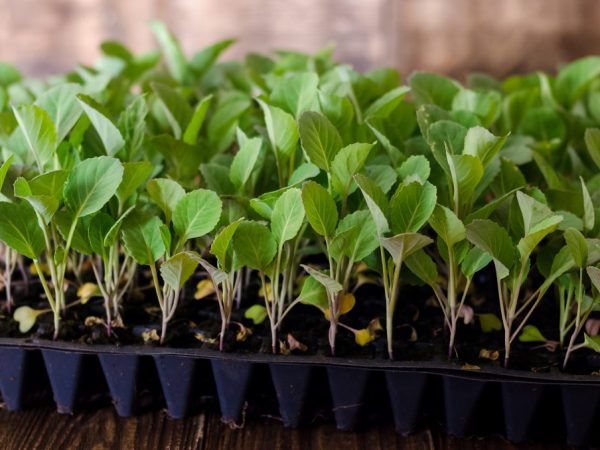Features of growing early cabbage in the open field
Early varieties have short ripening times and require careful maintenance. Growing early cabbage outdoors goes through a number of stages.

Features of growing early cabbage in the open field
Features of early cabbage
Cabbage comes in many varieties. There are 3 varieties of vegetables: early-ripening, mid-ripening, late-ripening. It differs from other species in terms of ripening, as well as in taste. Early maturing varieties are not intended for storage or sourdough, they are consumed only fresh.
Planting early cabbage starts with choosing the right seeds. Gardeners prefer the white-headed look. Immunity to light frosts allows you to get a young head of cabbage from the first months of summer.
The basic cultivation of early cabbage begins with seedlings. The time of sowing seeds for seedlings is from the end of February to the end of March. From the moment the sprouts emerge and until the seedlings are planted in open ground, a certain period must pass, for early maturing varieties it is 45-60 days. Seedlings are prepared both on an industrial scale and at home (in a greenhouse, on a windowsill).
Soil preparation
You need to prepare good soil for growing early cabbage species:
- Soil preparation begins in the fall. Organic fertilizers are added.
- The depleted soil is not used, they do not take the land after cruciferous crops (cabbage, radish, colza, rapeseed).
- The new soil should have enough micronutrients. It is mixed with humus (cow, poultry) and wood ash (natural antiseptic), or peat, potassium, and superphosphates are added.
- Sour mail is limed. Crop rotation helps to protect against diseases and unnecessary insects.
The soil should be fertile and breathable.
Planting seeds
Seeds are treated with any disinfecting method: potassium permanganate, hot water, chlorine, laundry soap.
Sow in cassettes or disposable cups (1 pc.). Growth stimulants can be used.
Rules for growing early cabbage seeds:
- prepared seeds are planted to a depth of 1.5 cm;
- watered abundantly, no longer moisturize;
- the container is covered with a film;
- adhere to a temperature of at least 20 ° C;
- the culture is photophilous, the seeds are germinated with abundant daylight.
In the absence of sunlight and in a closed room, it is permissible to use a fluorescent lamp. After 3-6 days, sprouts appear, the temperature is lowered to 15 ° C. The film is removed; as soon as the first leaves are tied, they begin to harden the seedlings.
Constant loosening supplies oxygen to the soil. 1.5-2 weeks after seed germination, the seedlings are watered with a pink solution of potassium permanganate.
Picking

Seedlings need a mandatory pick
Two weeks later, young sprouts dive:
- half an hour before the procedure, they are watered;
- carefully take out the sprout with the ground;
- shorten the root by 1/3 of the length;
- deepen the sprout to the first leaf;
- planted in individual cups.
This technology avoids gross injury to the plant. At the time of planting seedlings in open ground, the root system is strengthened. Diving is not required if the seeds were originally planted in individual containers.
Growing seedlings in a greenhouse
The process of growing early cabbage and its seedlings in a greenhouse is not much different from home. An additional layer of film is stretched over the tables, closer to the greenhouse roof. The care as well as the temperature conditions remain the same.
For hardening, the seedlings are taken out into the street. This is best done a week before planting outdoors. In case of frost, young seedlings are returned to the greenhouse.
Landing in open ground
Signs of ready-made seedlings: 5-7 confident leaves on the plant, length from 10 cm.
Seedlings are planted in prepared soil in the fall (dug up, leveled, fertilized). Mineral fertilizers (potassium, phosphorus) are added in the spring.
Seedling planting rules:
- loosen the ground with a rake;
- prepare holes, landing pattern - 50 x 40;
- moisten each well, add growth stabilizers if necessary;
- plant ready-made seedlings in the hole, deepen to the first leaves;
- cover and compact with earth;
- re-wet the bush.
It is necessary to plant a crop taking into account its growth and variety. Planting scheme for early maturing varieties:
| Hybrid white | 50*40 |
| Kohlrabi | 35*45 |
| Color | 30*50 |
| Brussels | 55*65 |
| Savoy | 35*55 |
Seedlings are planted loosely, in a well-lit place. Additionally, sand is added to each hole before planting. The best time for work is early morning.
After planting, the culture is covered with foil or agrofibre. In such conditions, the vegetable is less susceptible to disease and frost. The materials are removed when weather conditions have stabilized and the seedlings have hardened.
Culture care
To grow early cabbage, care rules are followed. It is necessary to moisten the seedlings only after the first heads are tied, no more than 2-3 times a week.
Be sure to weed and loosen the ground cover. After the first weeding, additional pest and disease care products are sprayed. Particular attention is paid to the bottom sheets of culture.
Organic and chemical fertilizers help grow early cabbage varieties. The plant is treated with any special preparations the required number of times.
Conclusion
Growing cabbage in open soil is an inexpensive but painstaking task. The correct choice of hybrid seeds, preparation and planting require skill. Good seedlings in the open field are quickly adopted. Feeding with fertilizers and avoiding pests save the crop.
The variety is not intended for long-term storage. Heads of cabbage are consumed fresh. The beneficial properties are identical to other types of vegetables.

